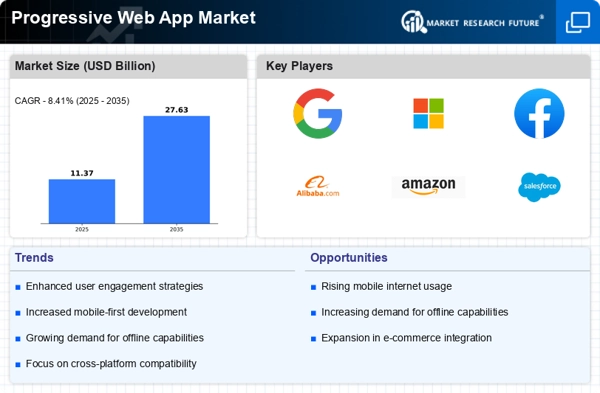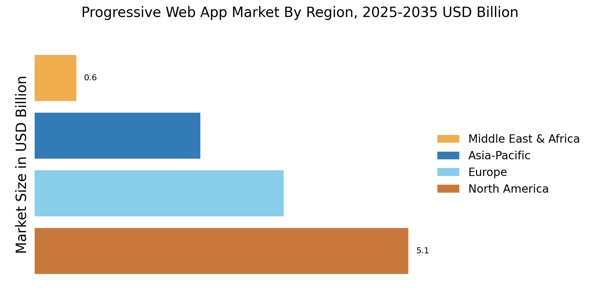Enhanced Performance and Speed
Performance and speed are critical factors influencing the Progressive Web App Market. Progressive web apps are designed to load quickly and provide a smooth user experience, even in low-network conditions. This capability is particularly appealing to businesses aiming to retain users and reduce bounce rates. Research indicates that a one-second delay in loading time can lead to a 7% reduction in conversions. As a result, organizations are increasingly investing in progressive web apps to enhance their performance metrics. The emphasis on speed and efficiency is likely to propel the growth of the Progressive Web App Market as companies strive to optimize user engagement.
Cost-Effectiveness of Development
The Progressive Web App Market benefits from the cost-effectiveness associated with developing progressive web apps. Unlike traditional native applications, which require separate development for different platforms, progressive web apps allow for a single codebase that works across all devices. This not only reduces development time but also minimizes maintenance costs. Businesses are increasingly recognizing the financial advantages of adopting progressive web apps, as they can allocate resources more efficiently. Market analysis suggests that companies can save up to 30% on development costs by choosing progressive web apps over native solutions. This financial incentive is likely to drive further adoption within the Progressive Web App Market.
Integration with E-commerce Solutions
The integration of progressive web apps with e-commerce solutions is a significant driver in the Progressive Web App Market. As online shopping continues to gain traction, businesses are seeking ways to enhance their e-commerce platforms. Progressive web apps provide features such as push notifications, easy checkout processes, and improved loading times, which are essential for a successful online shopping experience. Data suggests that progressive web apps can increase conversion rates by up to 20% compared to traditional websites. This potential for improved sales performance is prompting more e-commerce businesses to adopt progressive web apps, thereby fueling growth in the Progressive Web App Market.
Rising Demand for Mobile Accessibility
The Progressive Web App Market experiences a notable surge in demand for mobile accessibility. As mobile device usage continues to rise, businesses are increasingly seeking solutions that provide seamless experiences across various platforms. Progressive web apps, with their ability to function on any device with a web browser, cater to this need effectively. According to recent data, mobile devices account for over 50% of global web traffic, indicating a shift in user behavior. This trend compels companies to invest in progressive web apps to enhance their reach and engagement. The Progressive Web App Market is thus poised for growth as organizations prioritize mobile-first strategies to meet consumer expectations.
Growing Emphasis on Offline Capabilities
The Progressive Web App Market is witnessing a growing emphasis on offline capabilities. As users demand uninterrupted access to applications, even in the absence of a stable internet connection, progressive web apps offer a viable solution. By utilizing service workers, these apps can cache content and allow users to interact with them offline. This feature is particularly beneficial for businesses targeting regions with inconsistent internet connectivity. The ability to function offline enhances user satisfaction and retention, making progressive web apps an attractive option for companies. Consequently, the focus on offline capabilities is likely to drive further growth in the Progressive Web App Market.


















Leave a Comment